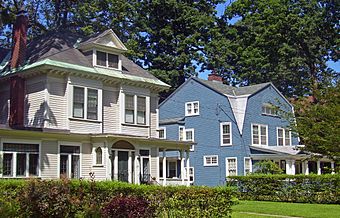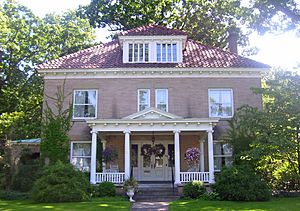General Electric Realty Plot facts for kids
Quick facts for kids |
|
|
General Electric Realty Plot
|
|

Houses on Stratford Road, 2008
|
|
| Location | Schenectady, NY |
|---|---|
| Area | 90 acres (36 ha) |
| Built | 1900–27 |
| Architectural style | Various early 20th century styles |
| NRHP reference No. | 80002763 |
| Added to NRHP | 1980 |
The General Electric Realty Plot, often called the GE Realty Plot or just The Plot, is a special neighborhood in Schenectady, New York. It covers about 90 acres (36 hectares) and is located just east of Union College.
This area was once empty land owned by Union College. In the late 1800s, the college sold it to General Electric (GE) to help pay off a debt. GE leaders then divided the land into lots and planned streets. Their idea for the layout was inspired by New York City's famous Central Park. They built houses on the land, with rules about how big the lots had to be and how much the houses should be worth.
Some of the first fully electric houses in the U.S. were built here by GE. These were used as examples to show off new electric technologies. Many GE scientists and local business people moved into the neighborhood. These scientists worked at GE's research lab nearby and invented many things, getting over 400 patents. Some even worked on their inventions at home in The Plot!
By 1927, about 100 houses were built. One of these homes later belonged to Irving Langmuir, a GE chemist who won the Nobel Prize in Chemistry. His house is now a National Historic Landmark. In 1980, the entire neighborhood was recognized as a historic district and added to the National Register of Historic Places. This means it's a special place protected for its history.
Today, fewer GE employees live in The Plot, but the houses are still very valuable. Residents pay some of the highest property taxes in the area. Special rules from the neighborhood group and the city help keep its historic look.
Contents
Exploring The GE Realty Plot
The GE Realty Plot is shaped like a square and is mostly surrounded by streets. To the west, Lenox Road separates it from Union College. Nott Street is the northern border, and Glenwood Boulevard is the eastern border.
Nature and Design
A small stream called College Creek flows through the middle of the neighborhood. It creates a deep, wide ravine. Four old bluestone bridges cross this creek, adding to the area's charm. Many old, tall trees also grow throughout the district.
The houses in The Plot sit on large lots, usually at least 70 by 140 feet (21 by 43 meters). They are set back from the streets, giving them plenty of space. Most homes are built in styles like Colonial Revival or Georgian Revival. You might also see some Mission Revival, Queen Anne, or Shingle Style homes.
The Steinmetz Memorial is the only open park space in the district. It is named after Charles Proteus Steinmetz, a German-born electrical engineer. He was very important for making alternating current (AC) electricity possible. Steinmetz's house and his backyard lab used to be where the Memorial is now.
A building at 1184 Rugby Road was once a school and was used for many years. Only a few new buildings have been added to the district since the early 1900s. These newer buildings are not considered "contributing" to the historic feel because they were built much later.
The Plot's Story
In 1899, Union College needed to pay off a $30,000 debt. They decided to sell two large pieces of land. People in the city wanted the land to become a public park. But then, leaders from General Electric stepped in. GE had grown very fast since Thomas Edison moved his company to Schenectady in 1886. GE bought the land from the college for $57,000, which helped the college pay off its debt.
Building a Dream Neighborhood
GE formed a company called Schenectady Realty Company to buy and develop the land. Their main goal was to create a nice place for GE executives and scientists to live. This would encourage them to stay with GE instead of leaving for other companies. It took until 1903 to prepare the streets, put in water and sewer pipes, and build the bridges.
The plan for the neighborhood was created by experts in urban planning. They were inspired by New York City's Central Park. Instead of straight streets, they designed gentle curves, like the paths in a park. They also tried a new idea called "sod gutters," where there were no curbs on the paved streets. This made the area feel even more like a park.
The rules for building were written into the deeds for each lot. Each lot could only have one single-family house. The house had to be worth at least $4,000, which was almost twice the average home value in Schenectady at the time. Building had to start within two years of buying the lot. There were also rules about how far back houses had to be from the street and how big the lots had to be. Fences between properties were limited to 3 feet 6 inches (107 cm) tall, just for decoration.
The streets were named after famous writers like Sir Walter Scott and important New England families like Adams and Lowell. Rugby Road was named because a nearby field was used for rugby games. Nott Road was already there, named after Union College president Eliphalet Nott.
Every winter, an area behind the Brown School was flooded to make an ice skating pond for residents. They even got special tags to show they lived in The Plot. The fire hydrant used to flood the pond is still there!
Houses sold quickly. Some non-GE residents moved in, including the city's mayor, F.F. Eisenmanger. In 1912, another mayor, George R. Lunn, who was New York's first Socialist mayor, had the city take over street maintenance. This led to sidewalks being installed, which changed the original "sod gutter" look a bit.
By 1927, almost all the lots were bought and had houses built on them. Since then, only five new buildings have been constructed in the district.
Keeping The Plot Special
The GE Realty Plot is one of four historic districts in Schenectady. This means it's protected by the city's Historic Commission. This group of seven members meets once a month. If someone wants to change a historic building in The Plot and the change can be seen from the street, the commission must approve it.
Houses in The Plot are very valuable, some worth $200,000 to $400,000. Many residents pay over $10,000 each year in property taxes to the city, county, and school district.
There is also a neighborhood association called the Realty Plot Association. They publish a newsletter, organize house and garden tours, and work to keep the neighborhood's historic feel. They even welcome new residents with a bottle of champagne and a book about the neighborhood's history!
Union College owns some houses in The Plot. In the late 1900s, the college wanted to use some of these houses for offices and student housing. Residents disagreed, saying the rules for the neighborhood didn't allow businesses. They went to court. In 2001, a state court said Union College could use the houses this way. The court decided that since the college is a nonprofit and was there before The Plot was created, the original rules likely didn't mean to stop college activities.
Important Homes and Their Residents
Many homes in The Plot are special because of the famous people who lived in them.
- 67 Union Avenue: This was the first home built in 1900 for Edwin W. Rice, a GE executive and one of the founders of General Electric.
- 1155 Avon Road: One of the first all-electric houses in the country when it was built in 1905.
- 6 Douglas Road: This was the first all-electric "Gold Medallion" house in the nation in 1901.
- Ernst Alexanderson House, 1132 Adams Road: Alexanderson was a pioneer in radio and television. He held 322 patents! The first television broadcast was received here in 1927.
- Ernst Julius Berg House, 1336 Lowell Road: Home of the person who produced the first two-way radio program in the U.S.
- William D. Coolidge House, 1480 Lenox Road: Home of the inventor of the modern X-ray tube. He later became GE's research director.
- Caryl Parker Haskins House, 1166 Avon Road: Home of an entomologist (someone who studies insects) who taught at Union College.
- Albert Hull House, 1435 Lowell Road: Home of the inventor of the magnetron. This invention was key to developing radar and microwave ovens. He held 94 patents.
- Irving Langmuir House, 1176 Stratford Road: From 1919 until he died in 1957, this was the home of Irving Langmuir. He won the 1932 Nobel Prize in Chemistry and was the first industrial chemist to receive this honor. This house is a National Historic Landmark.
- George R. Lunn House, 1299 Stratford Road: Lunn was the first Socialist mayor elected in New York. He later served as lieutenant governor for a term.
- Chester Rice House, 1161 Lowell Road: One night in the 1930s, Rice, a GE engineer, bounced radio beams off nearby vehicles. This was one of the earliest tests of radar.
- Edwin Rice House, 1050 Avon Road: Edwin Rice built this house for himself in 1905.





